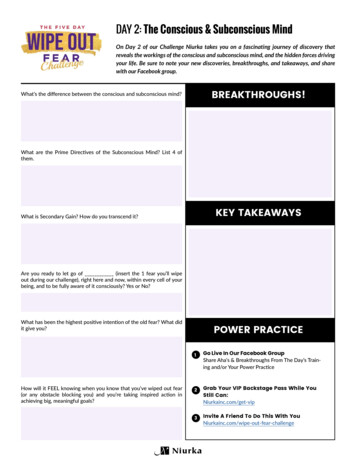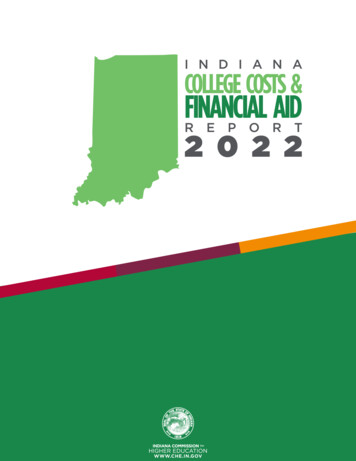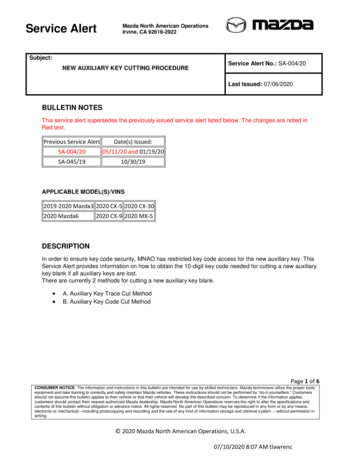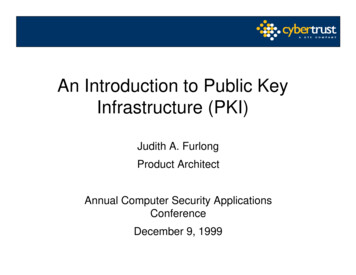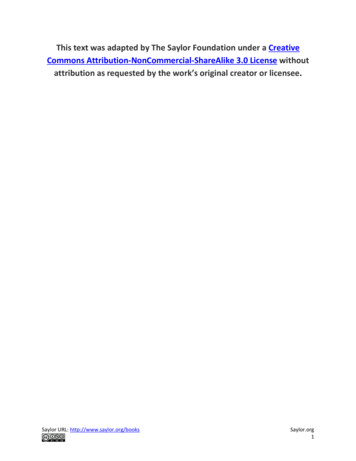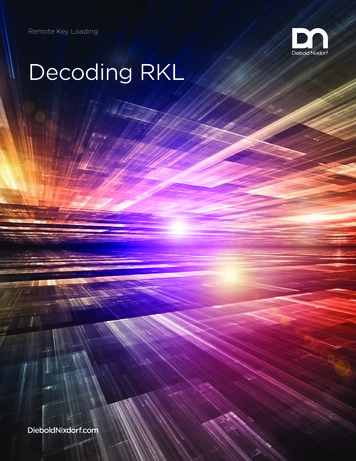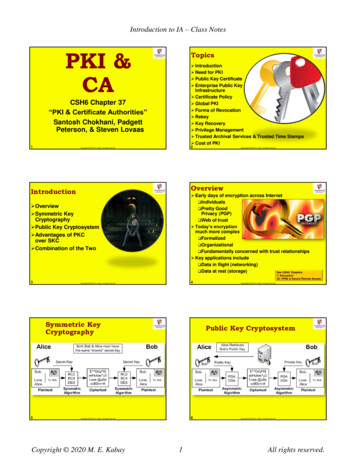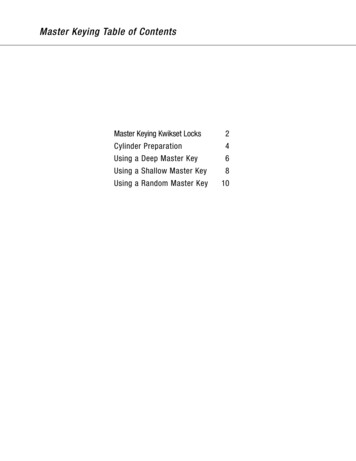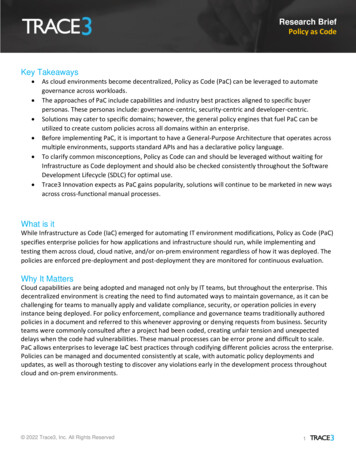
Transcription
Research BriefPolicy as CodeKey Takeaways As cloud environments become decentralized, Policy as Code (PaC) can be leveraged to automategovernance across workloads.The approaches of PaC include capabilities and industry best practices aligned to specific buyerpersonas. These personas include: governance-centric, security-centric and developer-centric.Solutions may cater to specific domains; however, the general policy engines that fuel PaC can beutilized to create custom policies across all domains within an enterprise.Before implementing PaC, it is important to have a General-Purpose Architecture that operates acrossmultiple environments, supports standard APIs and has a declarative policy language.To clarify common misconceptions, Policy as Code can and should be leveraged without waiting forInfrastructure as Code deployment and should also be checked consistently throughout the SoftwareDevelopment Lifecycle (SDLC) for optimal use.Trace3 Innovation expects as PaC gains popularity, solutions will continue to be marketed in new waysacross cross-functional manual processes.What is itWhile Infrastructure as Code (IaC) emerged for automating IT environment modifications, Policy as Code (PaC)specifies enterprise policies for how applications and infrastructure should run, while implementing andtesting them across cloud, cloud native, and/or on-prem environment regardless of how it was deployed. Thepolicies are enforced pre-deployment and post-deployment they are monitored for continuous evaluation.Why It MattersCloud capabilities are being adopted and managed not only by IT teams, but throughout the enterprise. Thisdecentralized environment is creating the need to find automated ways to maintain governance, as it can bechallenging for teams to manually apply and validate compliance, security, or operation policies in everyinstance being deployed. For policy enforcement, compliance and governance teams traditionally authoredpolicies in a document and referred to this whenever approving or denying requests from business. Securityteams were commonly consulted after a project had been coded, creating unfair tension and unexpecteddelays when the code had vulnerabilities. These manual processes can be error prone and difficult to scale.PaC allows enterprises to leverage IaC best practices through codifying different policies across the enterprise.Policies can be managed and documented consistently at scale, with automatic policy deployments andupdates, as well as thorough testing to discover any violations early in the development process throughoutcloud and on-prem environments. 2022 Trace3, Inc. All Rights Reserved1
Research BriefPolicy as CodeApproachesPaC is an umbrella term referring to a variety of different policies automated across an enterprise. It isimportant to note that as PaC buyers are typically focused on finding a solution that meets their uniquepolicies and budgets, the market is differentiating solutions in the following domain categories: governance,security, operations and cost optimizations. Solutions within these domains cater to the buyer persona’sneeds by offering predesigned policy templates to match domain best practices. For example, a governancePaC solution may have templates provided to align the workflows to SOC standards. This would be appealingto those working in a compliance or governance organization; however, even though these solutions appear tobe domain-specific, most PaC solutions incorporate a general-purpose policy engine that can be leveraged toautomate custom policies across any domain in the enterprise. The following explains each domain in a bitmore depth and how to best begin implementing PaC within an organization.Governance as Code (GaC) allows enterprises to enact industry regulations and customize internal bestpractices across cost, availability, security, performance and usage. Within applications and infrastructure,predefined industry compliance standards (PICI-DSS, SOC, GDPR) and internal governance policies areautomatically enforced, as well as tested thoroughly for accuracy pre-deployed. Once deployed, these policiesare monitored for continuous refinement and recorded for audit trail purposes. Another industry recognizedname for this capability is Compliance as Code (CaC).Security as Code (SaC) creates consistency by allowing security and development teams to codify theenterprise’s security policies across multiple environments. SaC can be broken into three forms: conductingspecific tests on security policies, scanning architecture against vulnerabilities and creating access policies formonitoring and reviewing authorizations. Other industry names for SaC are: Secure DevOps, SecurityAutomation, Security by Design and Infrastructure as Code Security.Operational Excellence Policies automate the insights and best practices learned from operations and sitereliability engineers (SRE) in order to continuously ensure high availability of services in productionenvironments and improve supporting procedures. The goal is to limit human error and enable consistentresponse to events that occur. Examples of this would be policies to mandate at least a certain number ofservices or validation of new configurations.Cost Optimization Policies are created in order to ensure that development and operation costs aremonitored and regulated. Examples of cost optimization policies are tagging resources to cost centers orshutting down development environments outside of business hours.To help develop these policies, it is important to have complete visibility and a consistent asset inventory, aswell as a General-Purpose Architecture that creates a common framework across multiple environments,supports standard APIs and has a declarative policy language. Each solution, regardless of the domain, mayhave a different approach to the policy as code exercise. Some may implement policies through 2022 Trace3, Inc. All Rights Reserved2
Research BriefPolicy as Codeauthorizations, while others may leverage resource graphs or scan fields in order to develop an understandingof the environment and which policies should be executed. This implementation approach should beevaluated to select the right fit for an organization. Once policies are determined, policies can either beselected in the PaC platform from a prebuilt policy engine, such as Open Policy Agent (OPA), or can be custombuilt to meet the unique requirements of an enterprise. It is recommended that the policies be consistentacross development, deployment and runtime cycles in order to eliminate confusion and inconsistencies. Afterpolicies have been vetted, they should be thoroughly tested before implementation. After implementation,the PaC platform will continue to track these policies and provide alerts in case anomalies arise.Trace3 Innovation’s Point of ViewThe cloud security and governance markets are highly contested and rapidly evolving. As enterprisesgrow their cloud presence and begin to experience challenges, cloud providers and 3 rd party vendors areincreasing their governance functionalities. Policy as Code has the potential to enhance governance efficiencybut requires changes in people, processes and technology that can be disruptive during early stages ofadoption. There are some common misconceptions when it comes to implementing and leveraging Policy asCode. PaC can create and maintain policies regardless of how it was deployed and does not requireInfrastructure as Code to be adopted within the cloud environment. In fact, implementing a PaC solutionbefore IaC does not require a heavy lift and allows for centralized policy management sooner in anenterprise’s cloud journey. Another misconception is that checking policies pre-deployment will ensure theyare carried through seamlessly in runtime; however, the Software Development Lifecycle (SDLC) is dynamicand it is highly advised to check the same policies at every stage of the lifecycle to ensure consistency andavoid any variations in code.There are different types of buyers within an enterprise, including: governance-centric, security-centricand developer-centric. Each will have their own priorities and motivations for implementing particular PaC usecases. To remain competitive, it is important for vendors to ensure their offerings can reach the right audienceand scale as the market grows. To attract buyer personas, some vendors specialize in a particular domain andinclude these domain industry standard best practices as policy templates for enterprises to easily leverage intheir own codes. Vendors are also differentiating in the approach taken to implement the policies. Somevendors, such as Styra, focus on the authorization of certain resources; whereas, Fugue, for example, createsresource graphs to ensure analysis of all available resources in the policies. Security as Code is currently themost recognized form of PaC, with Compliance as Code undergoing a massive explosion in the market.However, even if these solutions claim to specialize in one domain, OPA and other policy languages aredesigned to be cross-functional and can be leveraged for any type of automated guardrail. Trace3 Innovationexpects that as enterprises begin to realize the benefits and PaC gains popularity, solutions will continue to bemarketed in new ways across cross-functional manual processes. 2022 Trace3, Inc. All Rights Reserved3
Research BriefPolicy as CodeRecent Acquisitions in PaC Market (2021-2022): Palo Alto Networks acquires Bridgecrew, March 2, 2021Sysdig Inc acquires Apolicy.IO Inc., July 20, 2021Accurics is acquired by Tenable, October 4, 2021Lacework Inc with Soluble, November 11, 2021Weaveworks Limited acquires Magalix Corporation, January 26, 2022Fugue joins Snyk, February 17, 2022Trace3 Innovation Perspective:As Policy as Code enables consistent policy enforcement across an enterprise, Trace3 Innovation recognizesthat these acquisitions signal a shift from manual or paper policies to automated governance. While themarket continues to mature, we expect PaC's value to expand into additional use case offerings and for PaCengines to continue to be leveraged in new ways. In order to prepare for this shift, organizations will need toacknowledge the shift away from traditional processes and towards a devops mindset. PaC requiresorganizations to adopt many DevOps methodologies, including: maintaining controls in a central repository,applying version control, and enabling automatic validation. Another important call-out when evaluating a PaCapproach is that most PaC engines are designed to address policies across an organization. Offerings may bedifferentiated by user persona and have best practices as policy templates for areas such as security,compliance, governance; however, most industry PaC engines can be leveraged to fit the needs of anyorganization.Solutions*All vendors provided are examples and is not meant to be an exhaustive list. Emerging technologies are subject to significant changes in market shareand relative capability.Security:Secberus is an Enterprise Governance Platform with an embeddedContinuous Adaptive Policy Assessment (CAPA) framework at its core.With this approach, you can establish a policy baseline that is risk-driven,adaptable, and scalable. The adaptable policies become the single sourceof truth for each pillar of governance across clouds and business units.Magalix sets out to accelerate the implementation of innovativetechnologies and productsby powering developers and security teams with the tools for them tocodify security and compliance in their software development lifecycle.” 2022 Trace3, Inc. All Rights Reserved4
Research BriefPolicy as CodeConcourse Labs automates cloud governance, protecting enterprise data,controlling risk, and accelerating success in the cloud.Styra enables enterprises to define, enforce, and validate security acrosstheir Kubernetes environments. With a combination of Open Source(Open Policy Agent) and commercial solutions (Declarative AuthorizationService), Styra provides compliance guardrails to secure applications andease compliance. Styra’s policy-as-code solution lets DevOps and Securityteams mitigate risks, reduce human error, and accelerate appdevelopment.Tigera is a provider of integrated, secure, policy-driven cloud-nativenetworking solutions for enterprises looking for secure application andworkload delivery across private, public and hybrid clouds. Tigera issolving the networking and security problems inherent in deploying andenforcing policy in large private, public, and hybrid enterprise clouds.Prisma Cloud embeds comprehensive security across the softwaredevelopment cycle. The platform identifies vulnerabilities,misconfigurations and compliance violations in IaC templates, containerimages and git repositories. It offers IaC scanning backed by an opensource community, and image analysis backed by years of containerexpertise and threat research. With centralized visibility and policycontrols, engineering teams can secure their full stack without leavingtheir tools, while security teams can ensure that only secure code isdeployed.Accurics helps companies secure cloud native infrastructure throughoutthe DevOps lifecycle and eliminate risk posture drift.Shift Security to the left by Prancer's end-to-end cloud security platform.Prancer's static code analyzer for Infrastructure as Code (IaC) enforcescloud security posture right from the development lifecycle. And ourcontinuous compliance engine scans your cloud in real-time based onPolicy as Code. 2022 Trace3, Inc. All Rights Reserved5
Research BriefPolicy as CodeCompliance:Stacklet implements governance as code in the same way infrastructure isbeing managed as code today. It provides development and securityengineering teams with an easy to use, standardized language forenforcing governance policies in large scale, dynamic cloud environments.JupiterOne is a cloud-native security and compliance platform built on agraph data model. It enables users to create and manage their entiresecurity process from policy creation to compliance & certifications andto operating a secure cloud infrastructure while a company quickly growsand evolves. It is a platform that enables security in digitaltransformation.NexaStack helps organizations to use and manage multiple differentautomation frameworks through a single platform. Enterprises canexperience centralized Governance of Multiple Public Cloud Providersunder one roof for an easier shift towards the multi-cloud environmentapproach and efficient management of the same through the use ofNexaStack as an IAC platformChef Compliance helps organizations streamline their ability to stand upand maintain compliant IT infrastructure, whether on premises or in thecloud. Built on technology proven at extreme scale, including Chef InSpec,Chef Compliance leverages certified, curated audit and remediationcontent to help organizations quickly meet industry standards such as CISbenchmarks and DISA-STIGs. The product offers flexibility to easily applyand track waivers and tune controls to enterprise-specific needs.Cross-Functional:Pulumi provides the cloud development model: helping Development andDevOps teams get their code to the cloud quickly and collaboratively.Pulumi provides frameworks and libraries to define, deploy, and managecloud services -- from serverless to container to virtual machines, usingpure code. 2022 Trace3, Inc. All Rights Reserved6
Research BriefPolicy as CodeFugue, previously known as Luminal, simplifies cloud operations with itssoftware-defined system for orchestrating and enforcing cloudinfrastructure at scale. Teams can use Fugue to declare the desired stateof cloud infrastructure and policies in a collaborative, human-friendlyprogramming language and automate the provisioning, management andteardown of complex cloud environments, while continuously enforcinginfrastructure state and policy compliance.Cycode is a source code visibility and protection company. Cycode utilizesits Source Path Intelligence engine to deliver comprehensive visibility intoall of an organization's source code and automatically detect and respondto anomalies in access, movement, and usage.HashiCorp is an open-source software company. HashiCorp provides opensource tools and commercial products that enable developers, operatorsand security professionals to provision, secure, run and connectsdistributed application infrastructure.Checkov scans cloud infrastructure configurations to findmisconfigurations before they're deployed. Checkov uses a commoncommand line interface to manage and analyze infrastructure as code(IaC) scan results across platforms such as Terraform, CloudFormation,Kubernetes, Helm, ARM Templates and Serverless framework.env0 provides an automated, collaborative remote-run workflowsmanagement for cloud deployments on Terraform, Terragrunt andcustom flows. env0 enables users and teams to jointly govern clouddeployments with self-service capabilities.Spacelift is a specialized, Terraform-compatible continuous integration &deployment (CI/CD) platform for infra-as-code. 2022 Trace3, Inc. All Rights Reserved7
These personas include: governance-centric, security-centric and developer-centric. Solutions may cater to specific domains; however, the general policy engines that fuel PaC can be utilized to create custom policies across all domains within an enterprise. Before implementing PaC, it is important to have a General-Purpose Architecture .
